本帖最后由 seven_nana 于 2023-3-24 21:46 编辑
日德兰纪念系列 - 军舰建造篇 - 第五章 - 军舰设计的要求与取舍
本帖内容未经允许不得转载
主要参考资料:
British Battleships of World War One, 作者R. A. Burt
British Battleships 1919-1945, 作者R. A. Burt
The British Battleship 1906-1946,作者Norman Friedman
British Cruisers: Two World Wars and After,作者Norman Friedman
British Destroyers: From Earliest Days to the Second World War,作者Norman Friedman
British Submarines in Two World Wars,作者Norman Friedman
Fighting the Great War at Sea: Strategy, Tactics and Technology,作者Norman Friedman
The Grand Fleet: Warship Design and Development 1906-1922,作者D. K. Brown
The Battleship Builders: Constructing and Arming British Capital Ships,作者Ian Johnston & Ian Buxton
Lost in the Fog of War: Royal Navy Cruiser Designs for Trade Protection 1905-1920,作者David Murfin
Es and Super-Es,作者K. D. McBride
In Defence of Naval Supremacy: Finance, Technology, and British Naval Policy, 1889-1914,作者Jon Tetsuro Sumida
Sir John Fisher's Naval Revolution, 作者Nicholas A. Lambert
Die Deutschen Kriegsschiffe 1815-1945,作者Erich Gröner
The Kaiser's Battlefleet: German Capital Ships 1871-1918,作者Aidan Dodson
German Battlecruisers of World War One: Their Design, Construction and Operations,作者Gary Staff
From Ironclads to Dreadnoughts: The Development of the German Navy 1864-1918,作者Dirk Nottelmann
The Development of the Small Cruiser in the Imperial German Navy,作者Dirk Nottelmann
German Destroyers of World War Two,作者M. J. Whitely
The U-Boat - The Evolution and TechnicaI History of German Submarines,作者Eberhard Rössler
在先前的四个章节中,我们陆续介绍了19世纪末至20世纪初的英德两国海军的军舰建造情况、费舍尔发起的无畏舰革命、以及大战前夕时的英德造舰竞赛。在阅读完这些内容后,对于英德双方的军舰建造情况,相信各位读者已经形成了基本的认知。在本章中,我们将对具体的军舰设计细节,做出进一步的深入剖析,以便各位读者能对这个话题形成更为深入的认知。
一、战列舰与战列巡洋舰之间的差异与融合
在第三章 - 费舍尔与无畏舰革命中,我们已经对无畏舰革命进行了详细的介绍。通过这场革命,战列舰和装甲巡洋舰的设计,都完成了向全重炮设计的转变。在第四章 - 英德造舰竞赛中,我们还介绍过,在1911年时,英国海军正式将采用全重炮设计的装甲巡洋舰,改名为战列巡洋舰。因此,那个时代的英国海军主力舰,是分为战列舰与战列巡洋舰两类的。不过,尽管这两类军舰的设计互有差异,但由于都采用了全重炮设计,因此可以统称为无畏舰。
那么问题来了,战列舰与战列巡洋舰之间的差异是什么?在第三章 - 费舍尔与无畏舰革命,我们介绍过,设计委员会给战列舰和战列巡洋舰设定的原则是:战列舰强调火力和防护,战列巡洋舰则强调火力和航速。换句话说,这两种军舰之间的差异,在于性能取舍上的不同。那么问题来了,有没有可能,将这种差异抹平,从而创造出同时拥有战列舰级别的防护和巡洋舰级别的航速的融合式设计呢?
早期的失败尝试
1、当时的军政界人物,普遍认为战列舰是海军实力的象征,但费舍尔本人却在撰写《海军的必需品》时就曾表示过,他不看好战列舰这种军舰的未来(详见第三章 - 费舍尔与无畏舰革命),因此在开展无畏舰革命的同时,费舍尔还提出,想要将战列舰和战列巡洋舰进行融合。根据Jon Tetsuro Sumida的说法(In Defence of Naval Supremacy: Finance, Technology, and British Naval Policy, 1889-1914, P.58-59):
At the end of February 1905 Fisher wrote to Balfour: Pith of Cruiser - She is a battleship in disguise! She is the coming Battleship. Why? Because of speed! That’s why really only one Battleship. Now elaborating a new design - Get rid of distinction of Battleships and Armoured Cruisers. Simply Armoured Ships!
在1905年2月底时,费舍尔向阿瑟·贝尔福(当时的英国首相)写信到:装甲巡洋舰就是经过伪装的战列舰,就是战列舰的未来发展趋势。为什么?因为航速优势!所以我们只建造了1艘战列舰(指无畏舰,而无敌级却建造了3艘)。现在我们应该推出一种新设计,来消除战列舰和装甲巡洋舰之间的差异,我们只需要一种装甲军舰就够了。
“There is no hyperbole in the statement,” Fisher later argued in the report of the Navy Estimates Committee of 16 November 1905, “that the gun-power and armour protection embodied in the new armoured cruiser design” meant “that no existing battleship could safely encounter her at the long ranges at which her superior speed would enable her to impose an action.” “How far will it be practicable in future [sic],” Fisher then asked, “to build all our armoured vessels to a single design, combining the speed of the armoured cruiser with the offensive and defensive strength of the battleship?” He concluded that “it is, indeed, so clear that if the armoured cruiser and the battleship could be combined in a single type, a tremendous advantage would be placed in the hands of our Admirals...Battle squadrons so composed would possess a flexibility hitherto unattainable, and a power hitherto undreamt of”.
后来,在1905年11月16日时,费舍尔在写给海军预算委员会的报告中表示:“我并没有在夸张,新式装甲巡洋舰所拥有的火力和防护水准,意味着现有的战列舰无法与其安全地交战,因为前者拥有航速优势,会选择在远距离上进行交战”。他又接着写道:“要到什么时候,我们才有可能只建造一种类型的装甲军舰呢?一种同时具备装甲巡洋舰的航速优势与战列舰的火力和防护优势的军舰?如果我们能将装甲巡洋舰与战列舰合并为一种军舰类型,那么就能获得巨大的优势。由这种军舰组成的部队,将会拥有此前难以企及的灵活性和难以想象的强大战斗力”。
2、费舍尔所设想的这种融合式设计,的确拥有强大的战斗力,但其吨位也会明显提升。根据Norman Friedman的说法(The British Battleship 1906-1946, P.95):
Fisher initially envisaged construction of a fusion (battleship/cruiser) design, which was apparently pursued as Design X4 (presumably for four turrets). Fusion meant battleship armour but battlecruiser speed (25 knots). To remain within acceptable dimensions, it adopted a new main battery layout: four rather than five turrets, the two waist turrets (en echelon) being triples. The 13.5in gun was apparently considered as an alternative weapon. To achieve speed plus armour plus guns required, unsurprisingly, much greater power, nearly double that of HMS Dreadnought. The ship would have displaced 22,500 tons, which must have seemed a great deal in 1905.
费舍尔所设想的这种融合式设计,代号为X4,可能指的是这个方案有4个炮塔。融合式设计,意味着战列舰级别的装甲和装甲巡洋舰级别的航速(25节)。为了将舰体尺寸控制在可接受的范围内,他们采用了一种新的炮塔布局:采用4座炮塔,其中位于舯部的两座炮塔,采用斜向布置,并且是三联装形式的。另外,他们也考虑过为其配备13.5英寸火炮。为了在不牺牲火力和防护的情况下实现高航速,该舰的动力输出几乎要比无畏号多出一倍。在此情况下,X4方案的排水量达到22,500吨,以1905年的标准,这无疑是一艘巨型战舰了。
3、费舍尔建立了一个新的设计委员会,去研究这种融合式设计。让人惊讶的是,这个由费舍尔钦点的委员会,居然推翻了费舍尔的设想。根据Jon Tetsuro Sumida的说法(In Defence of Naval Supremacy: Finance, Technology, and British Naval Policy, 1889-1914, P.59-60):
On 2 December 1905, Fisher ordered the formation of what amounted to a second Committee on Designs. Fisher stated that the committee would consider, among other things, “the fusion of the battleship and the armoured cruiser.” It was desired to bring about a fusion of the two designs by the next year.
在1905年12月2日时,费舍尔下令,组建一个新的设计委员会。他表示,这个委员会的研究内容,将包括“战列舰与装甲巡洋舰的融合”这个话题。他希望,能在下一年里,将这两种军舰合二为一。
But the need to develop an economical means of containing the dual threat posed by French and Russian battleships and armoured cruisers had ceased to exist following the heavy Russian naval losses suffered in defeats inflicted by the Japanese in 1905 and the ruin of Russian finance because of the war, which made a rapid naval recovery highly unlikely. The hostility of France’s relations with Germany - the only other European naval power of major consequence - ruled out the possibility of a naval alliance between these two nations, French naval power alone could offer no real threat to Britain’s naval security, and in any case the signing of the Entente Cordiale in April 1904 had laid the diplomatic basis for friendly Anglo-French relations. This left the rapidly expanding German fleet by itself as the only serious potential danger. The German navy, however, while strong in battleships, had few armoured cruisers, and little in the way of overseas bases to supply them even if she had; the British Isles, moreover, blocked easy access from German ports to the high seas, which compromised a German cruiser strategy from the start. In short, by the end of 1905 it was clear that whatever armoured cruiser peril still remained could be met by existing vessels, and that further British big-ship construction should be devoted to battleships.
然而,在新的国际形势下,英国已经不再需要用一种更为经济的手段(指融合式设计),去应对法俄两国的战列舰和装甲巡洋舰的双重威胁了。一方面,俄国在日俄战争中损失了大量军舰,且其财政状况也由于战争而陷入困境,因此其海军难以快速恢复元气。另一方面,由于法国和德国之间存在敌对关系,这两个国家不太可能形成海军同盟,因此单靠法国的海军力量,是不足以对英国的海上安全构成真正的威胁的。此外,由于在1904年4月时,英法两国已经签订了《英法协约》,因此在外交层面上,两国已经具备了建立良好关系的基础。又由于德国舰队当时正在快速扩张,因此当时真正会对英国海军构成威胁的,就只剩下德国海军了。然而,尽管德国海军有不少战列舰,但其巡洋舰是不太可能对英国构成威胁的,其原因在于:第一,德国海军的装甲巡洋舰数量较少;第二,德国海军掌控的海外基地也非常少;第三,不列颠群岛挡住了德国海军通往大洋的去路。有鉴于此,在1905年底时,凭借英国海军现有的装甲巡洋舰,完全足以应对其他国家海军的巡洋舰威胁了,因此接下来,英国海军的大型军舰建造计划,应集中在战列舰上。
The recommendations of the “Fusion Design” committee, whose report was ready in January 1906, reflected an appreciation of the change that had taken place in Britain’s strategic position. The committee argued, however, that the cost of such a vessel as compared with a Dreadnought-type battleship would force a reduction in the number of ships that could be built. Though the committee report admitted that a division of “Fusion” class vessels would be of great value “as a fast ‘Flanking’ Division,” they insisted that Britain had first to establish a clear numerical superiority in all-big-gun battleships before such a unit could be provided for.
至1906年1月,这个“融合式设计”委员会提交了他们的报告,其中就反映出了上述所说的英国海军战略态势的变化情况。该委员会表示,融合式设计的造价,会比无畏舰更贵,因此如果要建造这种军舰的话,那么其数量就会变少。尽管他们也承认,这种“融合式设计”军舰,能组成一支很有价值的快速侧翼分队,但他们还是强调,英国海军应先在全重炮战列舰方面建立明确的数量优势,随后才能建造这种快速侧翼分队。
There is no record of Fisher’s reaction to the report of the “Fusion Design” committee. He was in no position, however, to overturn the conclusions reached by a committee of his own making, which had been composed of many of his strongest supporters.
费舍尔是怎么看待“融合式设计”委员会的报告的呢?我们并没有相关的记录可循。然而,他当时是无法推翻这样一个由自己任命的委员会所得出的结论的,毕竟,这个委员会的成员,有很多都是他的铁杆支持者。
4、此后,英国海军还曾尝试以装甲巡洋舰的名义,来建造融合式设计,但最终也仅仅停留在了设计阶段。根据Norman Friedman的说法(The British Battleship 1906-1946, P.96-105):
The 1906-7 ships (Bellerophon class) were largely repeat Dreadnoughts...Controller (H B Jackson) added that ‘in preparing the design of the large fast armoured vessel, Fusion type, for future adoption, the dimensions should be such that they can be readily transported and shifted in existing basins in our dockyards and for this reason are not to exceed 600ft in total length’. That suggests that Jackson thought the fusion design was being shifted to the 1907-8 programme, not abandoned.
在1906-07财年,英国海军实际建造的,是在无畏号的基础上改进而来的柏勒洛丰级。不过,第三海务大臣亨利·杰克逊少将却表示:“针对未来会采用的融合式设计的军舰,其舰长应控制在600英尺以内,否则现有的海军船厂就难以容纳这种军舰了”。换句话说,他并不认为融合式设计被放弃了,只是认为这种设计被推迟到了1907-08财年。
For 1907-8 the Board proposed an armoured cruiser and battleships...The battlecruiser began as an improved Invincible with larger training arcs for the two waist turrets, so that they could fire across deck over wider arcs (60-70°) and with heavier armour...the alternatives being 9in side armour (A) and 10in side armour (B, C). A displaced 19,700 tons, B displaced 19,900 tons, C displaced 20,700 tons. A later Legend shows a slightly modified but heavier (20,900 tons) Design D...Since the new design had the same powerplant as the original, the extra features cost speed. The next step (E) was an attempt to gain back speed by increasing power and reducing the side armour to 9in. Compared to Invincible, Design E had more powerful guns (12in/50) and better protection. She would displace 21,300 tons. These might be considered an approach to a fusion design, but retained the thin turret and barbette armour of the original Invincible.
1907-08财年的造舰计划,原本是同时包括有战列舰和装甲巡洋舰的。其中,装甲巡洋舰的设计方案,在无敌级的基础上,扩大了舯部炮塔的射界,并加强了装甲防护水准。方案A的舷侧装甲厚度达到9英寸,方案B和C则达到10英寸,她们的吨位则分别达到了19,700吨、19,900吨、以及20,700吨。稍晚些时候出现的方案D,吨位则达到了20,900吨。由于这些方案的动力水准与无敌级相同,因此在吨位上涨的情况下,最大航速就有所下降了。因此,接下来的方案E,加强了动力水准,但将舷侧装甲厚度从10英寸降低到了9英寸,其吨位则上涨至21,300吨。与无敌级相比,方案E的火力更强(前者采用12英寸/45倍径火炮,后者采用12英寸/50倍径火炮)、防护水准也更为优秀。这些设计方案,有些接近于先前被搁置的融合式设计,但她们的炮塔和炮座防护水准,仅与无敌级相当,并未达到战列舰的水准。
Plans changed dramatically after a 12 June 1907 Board meeting...The projected 1907-8 battlecruiser was dropped in favour of a third battleship...The 12 June 1907 Board meeting sketched the 1908-9 Estimates. On the basis that the fourth improved battleship would complete the two battleship squadrons, the Board decided that the other two armoured ships of the programme should be large cruisers. After considering several alternatives, it fastened on something smaller and less expensive than an Invincible, armed with eight 9.2in guns and capable of 25 knots, with 6in armour (as in Invincible). This a mini-Invincible was faster than any foreign ship, yet capable of fighting the older German battleships. The only foreign cruiser it could not fight was the single German battlecruiser (Von der Tann) and three Invincibles could surely deal with her.
然而,在海军部委员会于1907年6月12日召开的会议上,这一切都被推翻了,该年度的装甲巡洋舰被取消了,其建造名额则让给了战列舰(该财年实际建造的是3艘圣文森特级战列舰)。在这场会议上,海军部委员会还就1908-09财年的造舰计划进行了讨论。由于自无畏号算起,当时已经建造或已经规划好的战列舰数量有7艘,因此再建造1艘改进版的圣文森特级战列舰(即后来的尼普顿号),就可以拥有8艘无畏型战列舰了(按照当时的编制,这些军舰可以组成2支战列舰中队)。在此情况下,该年度的其余2艘主力舰名额,就让给了装甲巡洋舰。在经过一番考虑之后,海军部委员会决定建造的,是一种吨位略小于无敌级,配备8门9.2英寸火炮、6英寸装甲、25节航速(后两项指标均与无敌级相同)的军舰。这种迷你版的无敌级,具有非常快的航速,同时又具备与老式德国战列舰进行对抗的实力。她们唯一无法招架的对手,就是德国海军的冯·德·坦恩号战列巡洋舰,但由于德国人当时只有1艘战列巡洋舰,因此3艘无敌级足以应对其威胁了。
When the 1908-9 programme was submitted, the two smaller cruisers were replaced by one modified Invincible, HMS Indefatigable. The shift was probably made because the Germans had ordered a second battlecruiser, indicating that the 9.2in ship was not sufficient. Nothing in the Cover explains what happened, but the urgency of the change suggests why Indefatigable was a modified Invincible rather than some version of Design E.
然而,1908-09年的造舰计划,后来又做出了调整,实际提交给议会时,那2艘吨位较小的装甲巡洋舰,已经变成了1艘改进版的无敌级,即不倦号。之所以会有此变化,原因可能是德国海军开工了第2艘战列巡洋舰(即毛奇号),而9.2英寸火炮的装甲巡洋舰不足以对抗此类军舰。至于不倦号的设计,为何是基于无敌级的,而不是基于方案E的,相关档案中并未做出解释——这或许与时间紧迫有关吧。
超无畏舰时代的战列巡洋舰的防护水准变迁
受到前述因素的影响,在12英寸火炮时代,英国海军实际建造的战列巡洋舰,都只拥有6英寸级别的装甲防护,因此在防护水准上要远逊于同时代的战列舰。至1909年时,英国海军开始建造搭载13.5英寸火炮的战列舰和战列巡洋舰,为了与12英寸火炮的无畏舰进行区分,搭载13.5英寸火炮的无畏舰也被称为超无畏舰。与12英寸战列舰相比,13.5英寸战列舰在火炮口径上有明显区别,在防护水准也有一定程度的进步,但在动力水准方面则差别不太大。然而,与12英寸战列巡洋舰相比,13.5英寸战列巡洋舰,在火炮口径、防护水准以及动力水准上都有很大的提升。从某种程度上可以说,13.5英寸战列巡洋舰,向着融合式设计的方向迈出了一大步。
狮级(及其后继舰)的装甲防护水准,比不倦级强得多,并且还略强于方案E。之所以会有如此提升,主要是为了与德国海军的战列巡洋舰进行对抗。根据Norman Friedman(The British Battleship 1906-1946, P.117 & P.129)和R. A. Burt(British Battleships of World War One, P.172 & P.234)的说法:
The general design for the new battlecruiser...represented a cruiser version of Orion, although originally it had been planned early in 1909 to duplicate Indefatigable’s layout with some modification where necessary. Uncertainty surrounding the German programme was clarified to a certain extent by information from a private source which reached the Admiralty before any of the British designs were approved. The projected Moltke-class battlecruisers would be considerably larger than had been anticipated, and any design to counter them would have to be much more powerful than the Indefatigable type...the Lion class...gave Britain the largest warships in the world...Side armour was 9in, 6in and 5in, like that of the heavily-armoured Battlecruiser E. However, turret armour was heavier (8in and 9in rather than 7in, as in the earlier battlecruiser designs).
1909-10财年的装甲巡洋舰的早期阶段的设计方案,是在不倦级的基础上改进而来的。但实际建造的狮级,则相当于巡洋舰版的俄里翁级(两者同为1909-10财年的设计)。之所以会有此差异,主要原因在于,在早期阶段的设计方案得到批准之前,英国海军获得了有关德国海军造舰计划的新情报,并发现毛奇级的吨位远比他们想象的更大,因此为了对抗这型军舰,就需要建造一种战斗力明显超过不倦级的军舰。在此情况下,狮级成为了当时世界上吨位最大的军舰。该级的舷侧装甲带,最厚处达到9英寸,与方案E相当;而炮塔装甲的最厚处同样也达到9英寸,比方案E更为厚重。
Lion still had a thinner belt than contemporary battleships...In Tiger, the maximum armour thickness remained the same as in Lion, but was more widely distributed.
不过,与同时代的战列舰相比,狮号的舷侧装甲带厚度,还是有较大差距的。至于虎号,其最大装甲厚度与狮级是相同的,但其覆盖范围要比狮级更大。
1912-1918年间的各种缺乏连贯性的设计突变
自无畏号和无敌级起,直至铁公爵级和虎号,英国海军的战列舰和战列巡洋舰,得到了持续不断的进化。尽管如此,排除从无畏舰到超无畏舰的跨越式升级,其余各级之间的设计变迁,还是有明显的连贯性的。然而,在进入15英寸时代后,英国海军建造的每一级主力舰,互相之间都具有显著的差异:伊丽莎白女王级是快速战列舰(航速比早先的战列舰更快),接下来建造的复仇级却是原教旨战列舰(航速与早先的战列舰相当);声望级是原教旨战列巡洋舰(防护水准与无敌级/不倦级相当),接下来建造的勇敢级是大型轻巡洋舰或轻型战列巡洋舰(拥有战列巡洋舰级别的火力与航速,但防护水准仅与轻巡洋舰相当),再接下来的胡德号尽管名义上是战列巡洋舰,但却具备战列舰级别的防护水准。为什么会出现这种现象呢?
伊丽莎白女王级战列舰
伊丽莎白女王级,是英国海军第一种配备15英寸火炮的战列舰。总体上来说,该级有些接近于融合式设计,然而其渊源,至今仍然是迷雾重重的。根据Norman Friedman(The British Battleship 1906-1946, P.133-135)和Nicholas A. Lambert(Sir John Fisher's Naval Revolution, P.246-248)的说法:
Churchill took office as First Lord in October 1911. The 1911-12 ships (Iron Dukes and Tiger) were being ordered. Preparation for the next year’s programme was underway. The Board planned to buy three battleships and one battlecruiser. It would probably have consisted of follow-ons to the 1911-12 ships...Once the 15in decision had been taken, it seems that sketch designs were drawn up of a ‘Super Tiger’ and possibly also a ‘Super Iron Duke’...The 1912-13 programme presented to Parliament in March 1912 included four ‘armoured ships’ whose design had not yet been settled...What happened next, in the 1912-13 programme, is not entirely clear...It seems that many or all of the papers surrounding the conception of the Queen Elizabeth class were destroyed, probably as early as 1914.
丘吉尔是在1911年10月时,成为海军大臣的。当时,英国海军已经订购了1911-12财年的主力舰,即铁公爵级和虎号。所以这个时候,他们正在为下一年的造舰计划做准备。海军部委员会,起初打算订购3艘战列舰和1艘战列巡洋舰。这些军舰,可能会延续1911-12财年的军舰的发展路线。在决定将口径升级至15英寸之后,他们似乎拿出了“超级铁公爵”和“超级虎”的草案。1912年3月时,他们将1912-13财年的造舰计划提交给了议会,但当时设计方案尚未决定,所以只是对议会说,要建造4艘主力舰。接下来发生了什么,就不太清楚了。围绕着伊丽莎白女王级的起源的相关档案,似乎早在1914年时便已经被销毁了。
Fisher persuaded Churchill to cancel the battleships projected under the 1912/13 program and instead “plunge” for a new model battlecruiser. In November 1911, the admiral forwarded his pupil sketch plans of a warship armed with eight 15-inch guns, fitted with oil fired boilers capable of propelling the ship at thirty knots and which relied upon extensive internal subdivision rather than heavy armor for protection...The three senior members of the Board—Briggs, Battenberg and especially Bridgeman, were equally opposed to giving up battleships in favor of the battle cruiser concept. Indeed, the first sea lord wanted “to get rid of the battle cruiser type” altogether. He championed the development of the heavily armored fast battleship type which later became known as the Queen Elizabeth class.
费舍尔一度曾说服丘吉尔,取消1912/13财年的战列舰建造计划,并推荐他建造一种全新的战列巡洋舰。在1911年11月时,费舍尔向丘吉尔发去了一份军舰设计草图:她搭载有8门15英寸火炮,配备的是全燃油锅炉,最大航速达到30节,防护方面则是依靠细致的内部分舱,而不是厚重的装甲。然而,海军部委员会内的三名高阶成员,弗朗西斯·布里奇曼(第一海务大臣)、巴腾堡的路易斯(第二海务大臣)、查尔斯·布里格斯(第三海务大臣),都反对不建造战列舰、只建造战列巡洋舰的做法。尤其是布里奇曼,更是想要完全不建造战列巡洋舰。在他的推动下,英国海军建造了具备厚重装甲的快速战列舰,即伊丽莎白女王级。
The Queen Elizabeths were designed for 25 knots. In fact they never made their design speed...What is less readily appreciated is that when they were designed it appeared that they would be about as fast as the German battlecruisers on a sustained seagoing basis...The extra knots were quite expensive: 75,000 SHP rather than 29,000 SHP...Churchill always maintained that without oil fuel the ships could not have reached their high design speed within their dimensions, but the fact that the design was accepted and then converted to oil fuel belies that.
伊丽莎白女王级的设计航速是25节,但实际上达不到这个水准(实际为24节)。较少为人所知的是,在设计阶段,英国海军认为这种军舰的航速,可以与德国战列巡洋舰的持续航速相媲美。与铁公爵级相比,伊丽莎白女王级的航速的确快了不少,但代价也并不小:前者的最大出力仅为29,000轴马力,而后者的最大出力则达到75,000轴马力。丘吉尔一直宣称,如果不采用全燃油动力的话,那么伊丽莎白女王级是无法在限定尺寸下实现高航速的,但事实上,该级最初的设计并非全燃油动力,而是在方案得到批准之后,才更改为全燃油动力的。
伊丽莎白女王级的三视图
伊丽莎白女王级战列舰,配备有8门15英寸火炮、14门6英寸火炮、4具21英寸鱼雷发射管(水下),主装甲带厚度13英寸,最大航速24节。
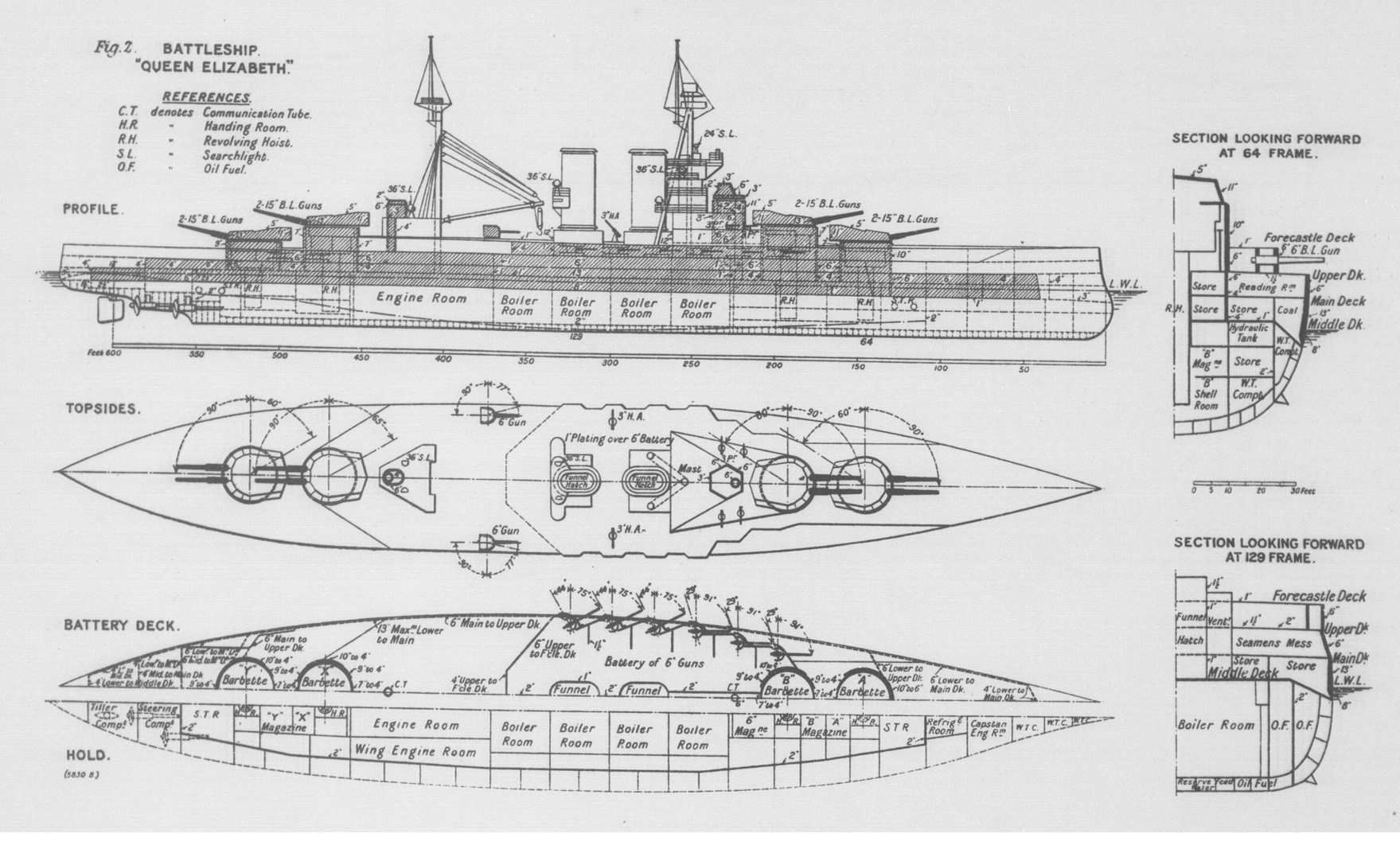
复仇级战列舰
复仇级,是英国海军第二种配备15英寸火炮的战列舰,其设计渊源也有一些不明晰之处,但可以确定的是,该级是预算限制和数量要求的双重作用下的结果。根据Norman Friedman的说法(The British Battleship 1906-1946, P.133-135; Fighting the Great War at Sea: Strategy, Tactics and Technology, P.382):
The 1913-14 programme...The number of ships (five) was set by the decision to out-build the Germans by 60 per cent. Available funding determined which five ships could be built...which ultimately included the five Royal Sovereign class battleships. The alternatives were: (a) one improved Tiger and four repeat Iron Dukes; (b) one improved Tiger and four improved Iron Dukes; or (c) four Queen Elizabeths or (d) two improved Tiger and two repeat Iron Dukes or (e) one improved Tiger and three Queen Elizabeths or (f) two improved Tigers and two improved Iron Dukes...The improved Tiger would have 15in guns and armour superior to the German Seydlitz. The improved Iron Duke would have 15in rather than 13.5in guns and a larger hull to carry them...Programmes (a), (c) and (d) all left additional money for smaller ships. Churchill considered the best alternatives (a) and (c), of which he was inclined to prefer (c) because it simplified the 1913-14 programme into (1) the fast capital ship for all purposes; (2) the fast light cruiser to destroy torpedo craft and for all scouting; (3) destroyers and (4) submarines...Unfortunately it offered him four rather than the desired five ships...Nothing in the set of printed Minutes explains how Churchill was persuaded to substitute five slow battleships for four fast ones in 1913-14.
在1913-14财年时,英国海军计划建造5艘主力舰。这个数量是规定死的,因为他们要实现对德六成优势。至于这5艘军舰能造成什么样,则取决于能获得多少资金。最后决定建造的,就是5艘复仇级。不过,当时还有其他方案可供选择:(a) 1艘改进型虎和4艘铁公爵,(b) 1艘改进型虎和4艘改进型铁公爵,(c) 4艘伊丽莎白女王,(d) 2艘改进型虎和2艘铁公爵,(e) 1艘改进型虎和3艘伊丽莎白女王,(f) 2艘改进型虎和2艘改进型铁公爵。改进型虎和改进型铁公爵都将配备15英寸火炮,改进型虎的装甲防护水准也会有所提升。在这些方案中,(a)、(c)、(d) 的总预算较低,可以省下一些钱,用于建造轻型舰艇。丘吉尔认为 (a) 和 (c) 都很不错,但更喜欢 (c),这样一来,1913-14财年的造舰计划就能简化为四种军舰:(1) 快速战列舰,(2) 舰队轻巡洋舰,(3) 驱逐舰,(4) 潜艇。但问题是,伊丽莎白女王级的价格昂贵,因此只能造4艘;换句话说,就是不符合5艘的需求。是谁说服了丘吉尔,让他同意在1913-14财年中,建造5艘慢速战列舰,而非他所设想的4艘快速战列舰呢?很可惜,这个问题并无纪录可循。
The main innovation was that the armour deck was the main rather than the middle deck. D’Eyncourt cited several advantages of moving up the armour deck. Most importantly, stability in the riddled condition would be much better than in recent designs. It was therefore possible to reduce initial metacentric height (GM). That in turn would make the ship a much better gun platform; she would roll much less and also more slowly.
复仇级的设计,有一个重要的创新之处:她们的防护甲板位于主甲板层,而非传统的中甲板层。造舰局长戴恩科特表示,这么布置防护甲板,有不少好处,其中最重要的是,在舷侧装甲带被击穿之后,采用该设计的军舰,稳定性会比原先那种设计好得多。在此情况下,设计师还可以降低军舰的初稳心高度,从而减缓军舰的横摇幅度和横摇周期,使其成为更为优秀的炮术平台。
复仇级的三视图
复仇级战列舰,配备有8门15英寸火炮、14门6英寸火炮、4具21英寸鱼雷发射管(水下),主装甲带厚度13英寸,最大航速22节。
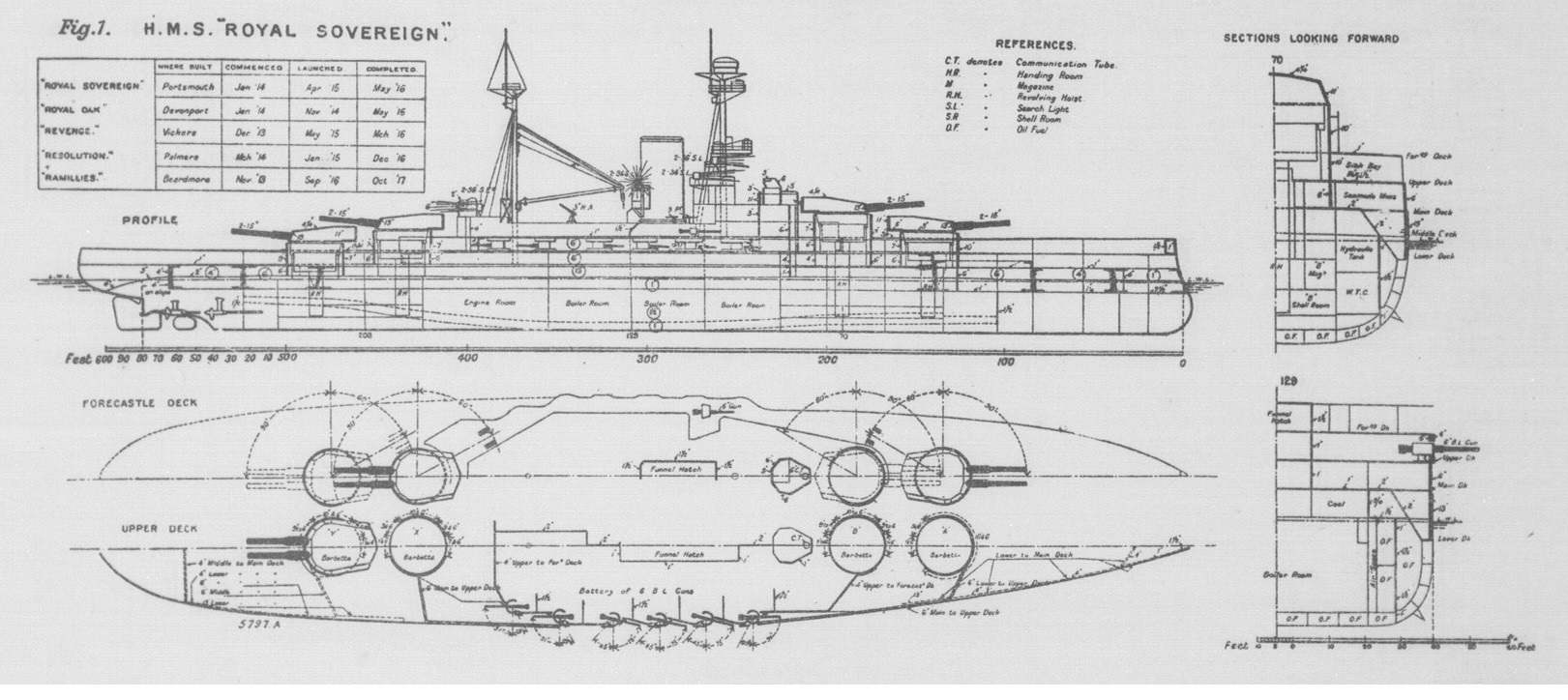
1914/15财年的战列舰设计方案
在1914/15财年时,英国海军原计划建造4艘战列舰,但由于战争爆发,该计划被搁置了。根据D. K. Brown的说法(The Grand Fleet: Warship Design and Development 1906-1922, P.53-54):
The 1914-15 building programme included four battleships, Agincourt of the Queen Elizabeth class, and three Royal Sovereigns, Resistance, Repulse and Renown.
在1914/15财年的造舰计划中,英国海军原本打算建造1艘伊丽莎白女王级的后继舰:阿金库尔号,以及3艘复仇级的后继舰:声望号、反击号、抵抗号。
There was also a ‘high speed battleship’ for the 1914-15 programme, submitted 8 July 1914 which was not accepted because of poor torpedo protection. It had eight 15in and sixteen 6in guns and a speed of 30kts at an overload power of 108,000hp (normal 85,000hp). Belt armour was 11in with deck 1½in. Slopes were omitted in view of the width of the boiler rooms.
另外,在1914年7月8日时,造舰局还提交过一种高速战列舰设计方案:8门15英寸火炮、16门6英寸火炮、主装甲带厚度11英寸,防护甲板厚度1.5英寸(但没有传统的倾斜段),常规出力85,000轴马力/过载出力108,000轴马力,最大航速30节。由于该方案的锅炉舱宽度过大,导致水下防护不佳,因此被否决了。
声望级战列巡洋舰
声望级,是英国海军第一种配备15英寸火炮的战列巡洋舰。该级的设计强调最大航速,但也为此牺牲了防护水准。根据Jon Tetsuro Sumida(In Defence of Naval Supremacy: Finance, Technology, and British Naval Policy, 1889-1914, P.290-291)、Norman Friedman(The British Battleship 1906-1946, P.170-172 & P.176-177)以及R. A. Burt(British Battleships of World War One, P.321 & P.324)的说法:
On 18 December, Fisher met with Eustace Tennyson D’Eyncourt, the Director of Naval Construction, to discuss the possibility of converting two recently laid down Royal Sovereign class battleships, upon which little work had been completed, into battle cruisers.
1914年12月18日时,费舍尔与造舰局长戴恩科特会面,讨论将近期刚开工、且进展很慢的2艘复仇级战列舰,改建为战列巡洋舰。
Fisher produced a quick description of what he had in mind: The Rhadamanthus type of Ocean going Battlecruiser 4 guns of 15in calibre, 20 guns of 4in calibre, 32 knots speed, Oil only, Same armour as Indefatigable. What will be size and cost?
费舍尔最初设想的方案,是这样的:拉达曼提斯级远洋战列巡洋舰,搭载4门15英寸火炮和20门4英寸火炮,纯燃油动力,最大航速32节,防护水准与不倦级相当。他要求造舰局长,对这种军舰的尺寸和造价进行估算。
Fisher soon became convinced that he could provide his ship with three rather than two turrets. On 19 December he sent DNC further characteristics: Speed 32 knots. Six 15in guns, twenty 4in guns. Armoured like Indefatigable. All oil.
费舍尔很快就发现,他可以为这些军舰争取到3座炮塔,因此在12月19日时,他更改了设计指标:6门15英寸火炮、20门4英寸火炮,纯燃油动力,最大航速32节,防护水准与不倦级相当。
On 21 December Fisher and D’Eyncourt came to an agreement on the dimensions, speed and armament of the new capital ship. “I fear you have missed my point,” Fisher argued to a skeptical Churchill that same day, about the 32-knot ‘Rhadamanthus’! The only vessel that can ‘catch’, not ‘keep up with’ the German battlecruiser Lützow, of 28 knots.
12月21日时,费舍尔与戴恩科特,就这种军舰的尺寸、航速、武备达成了共识。同样也是在这一天,费舍尔与丘吉尔发生了争辩,原因是后者对这种军舰持怀疑态度,而费舍尔则认为,想要抓住德国海军的最大航速为28节的吕佐夫号战列巡洋舰,就必须要建造这种最大航速为32节的军舰。
The DNC made it clear at the time that it was undesirable to apply such thin protection to ships of such great proportions, but he agreed that features of such magnitude could only be reached if the protective qualities were indeed scanty.
造舰局长明确表示,在当时的环境下,这个水准的装甲防护,是不够理想的。但他也同意,想要满足其他指标要求,就只能牺牲装甲防护。
The ship had a feature new to British practice: the belt sloped inward, increasing its effectiveness, particularly at longer ranges. The greater the range, the steeper the angle at which the shell hit, the greater the resistance.
在防护设计方面,该级采用了一个新的特征:其舷侧装甲带是向内倾斜的,因此可以提高防护效果,尤其是在远距离上的防护效果。因为距离越远,炮弹的落角就更大,因此就更难击穿这种倾斜装甲。
Two units, named Renown and Repulse, were ordered at the end of December. These vessels were roughly comparable to the Lion class in displacement, but were significantly less well-protected, nearly 20 per cent faster and carried a main armament of six 15-inch rather than eight 13.5-inch guns.
至12月底时,英国海军订购了2艘这种军舰,即声望号和反击号。声望级的排水量与狮级大致相当,航速提高了近20%,火力方面则是用6门15英寸火炮取代了8门13.5英寸火炮,但在防护方面则要薄弱许多。
The combination of very high speed and very light protection was less attractive after Jutland...After Renown and Repulse joined the Grand Fleet in September 1916, they were recalled almost immediately for a further refit to enhance their protective qualities...In 1918, it decided on a more extensive upgrade. One ship would use 360lb (9in) armour from the ex-Chilean battleship Almirante Cochrane, the other would have new plating, the newly-manufactured armour was allocated to Repulse.
在日德兰海战之后,极高航速和轻薄防护的组合,就变得不那么有吸引力了。1916年9月时,声望号和反击号加入了大舰队,但很快就被召回,接受装甲防护上的改造(主要是加强甲板厚度)。至1918年时,海军部决定对其防护水准进行再度加强,其中就包括将她们的主装甲带厚度提升至9英寸——反击号换上了专门为她制造的新装甲板,而声望号则使用了原本为智利海军的科克兰上将号战列舰制造的装甲板。
声望级的三视图
声望级战列巡洋舰,配备有6门15英寸火炮、17门4英寸火炮、2具21英寸鱼雷发射管(水下),主装甲带厚度6英寸(改装后为9英寸),最大航速32节。
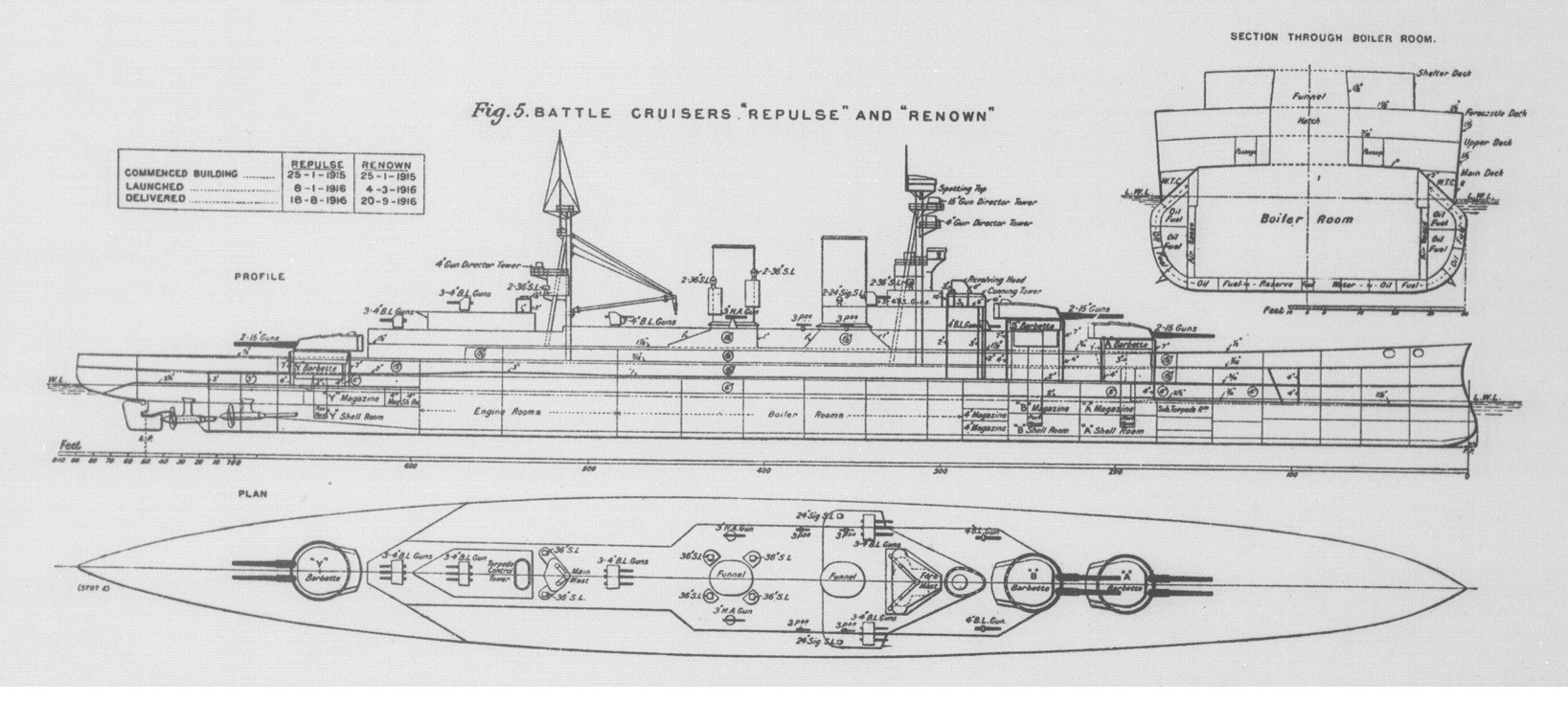
勇敢级战列巡洋舰
勇敢级,是英国海军第二种配备15英寸火炮的战列巡洋舰,她们是财政限制下的特殊产物。根据Jon Tetsuro Sumida(In Defence of Naval Supremacy: Finance, Technology, and British Naval Policy, 1889-1914, P.292)、Norman Friedman(The British Battleship 1906-1946, P.178 & P.180)以及R. A. Burt(British Battleships of World War One, P.333 & P.338 & P.341)的说法:
After the two Renowns, Fisher could get no more capital ships out of the Treasury - which was, however, willing to pay for cruisers. He therefore asked DNC for two ‘large light cruisers’, which he later called light battlecruisers: Courageous and Glorious.
在2艘声望级之后,财政部不愿再拨款建造主力舰了,但却愿意拨款建造巡洋舰。于是,费舍尔要求造舰局长设计一种大型轻巡洋舰。这就是勇敢号和光荣号的起源。后来,这种军舰又被称作是轻型战列巡洋舰。
The appellation of “light cruiser” for what were in fact battle cruisers was intended to deceive the Chancellor of the Exchequer. The justification of building such vessels for use in the Baltic to cover a landing of troops on the Pomeranian coast was also a cover. “I had a fierce time,” Fisher wrote to D’Eyncourt on 25 January, “with the First Lord—Very Fierce!—but we are to have two [large light cruisers]...if only we can make a good story for the Cabinet.” “It’s on the Baltic necessities,” he noted later, “that we will carry these ships through the Cabinet.”
将战列巡洋舰称作轻巡洋舰,只是一个用来欺骗财政部长的幌子。而将其用于波罗的海强袭计划、掩护士兵在波美拉尼亚沿岸地区登陆的说法,同样也是一个幌子。1915年1月25日时,费舍尔致信戴恩科特,他写道:”就大型轻巡洋舰这个话题,我与海军大臣之间的争吵很激烈,但最终统一了意见。只要能编出一个好故事来忽悠内阁,我们就可以建造这种军舰了“。费舍尔后来又写道:”波罗的海强袭计划,就是我们用来忽悠内阁建造这些军舰的理由“。
The design was, in general, a reduced edition of Renown, with ‘B’ turret suppressed and protection on light cruiser standard...Had it been possible to obtain sanction for further armoured vessels, they would have been a modified edition of Renown.
简单来说,勇敢级就是缩水版的声望级,她们减少了一座炮塔,同时防护水准下降到了轻巡洋舰的水准。如果没有财政部的限制的话,那么费舍尔会建造的,就是改进版的声望级了。
It was decided to fit the vessels with small-tube boilers, and they provided an increase of at least 30 per cent in power over the large-tube boilers on the same weight...They were the first large warships to have geared turbines...With gearing it was possible to use a lighter faster-running turbine without accepting the poor propeller efficiency associated with high RPMs.
另外,勇敢级还是英国海军第一种配备小水管锅炉和带有减速齿轮的蒸汽轮机的大型军舰。在重量相同的情况下,小水管锅炉的出力,要比大水管锅炉多出至少30%;而带有减速齿轮的蒸汽轮机,则能在保证螺旋桨驱动效率的前提下,降低蒸汽轮机本身的重量。
A third ‘large light cruiser’ was ordered slightly later: HMS Furious...The ever-increasing gun sizes fitted to capital ships reached their peak when it was proposed to fit two 18in single mountings in Furious as designed...Secondary armament...eleven 5.5in guns...Furious was completed as part carrier, with just one 18in gun and turret (‘Y’) on quarterdeck. Flying-off platform forward...Furious was taken in hand in November 1917 for further conversion. Her aft 18in gun, mainmast and torpedo control tower were removed, and a flight deck was fitted aft; to connect the flying-off platform (forward) with the landing platform (aft). In 1922 it was again decided to remove the funnel and superstructure and convert her to a fully-fledged aircraft carrier.
再后来,英国海军又建造了第3艘大型轻巡洋舰:暴怒号。该舰计划配备2门18英寸火炮,因此在火炮口径上达到了登峰造极的水准。副炮配置则是11门5.5英寸火炮。不过,在建造过程中,暴怒号被改造成了航空巡洋舰,她保留了舰艉的1门18英寸火炮,但舰艏区域则改造成了飞行甲板。至1917年11月时,暴怒号又再度接受了改造,舰艉的18英寸火炮、以及主桅和鱼雷火控塔都被拆除了,舰艉区域也被改造成了飞行甲板。至1922年时,英国人又对该舰的上层建筑进行了改造,将其改成了具备贯通式飞行甲板的航空母舰。
After a limited success in their cruiser role, Courageous and Glorious were finally earmarked for conversion to aircraft carriers although they would be reconstructed completely, and not in stages like Furious.
至于勇敢号和光荣号,在度过了一段不算太成功的巡洋舰生涯后,也被改造成了航空母舰。不过这2艘军舰,并没有像暴怒号那样分好几步接受改造,而是直接进行了重建。
勇敢级的三视图
勇敢级战列巡洋舰,配备有4门15英寸火炮、18门4英寸火炮、2具21英寸鱼雷发射管(水下),主装甲带厚度3英寸,最大航速32节。
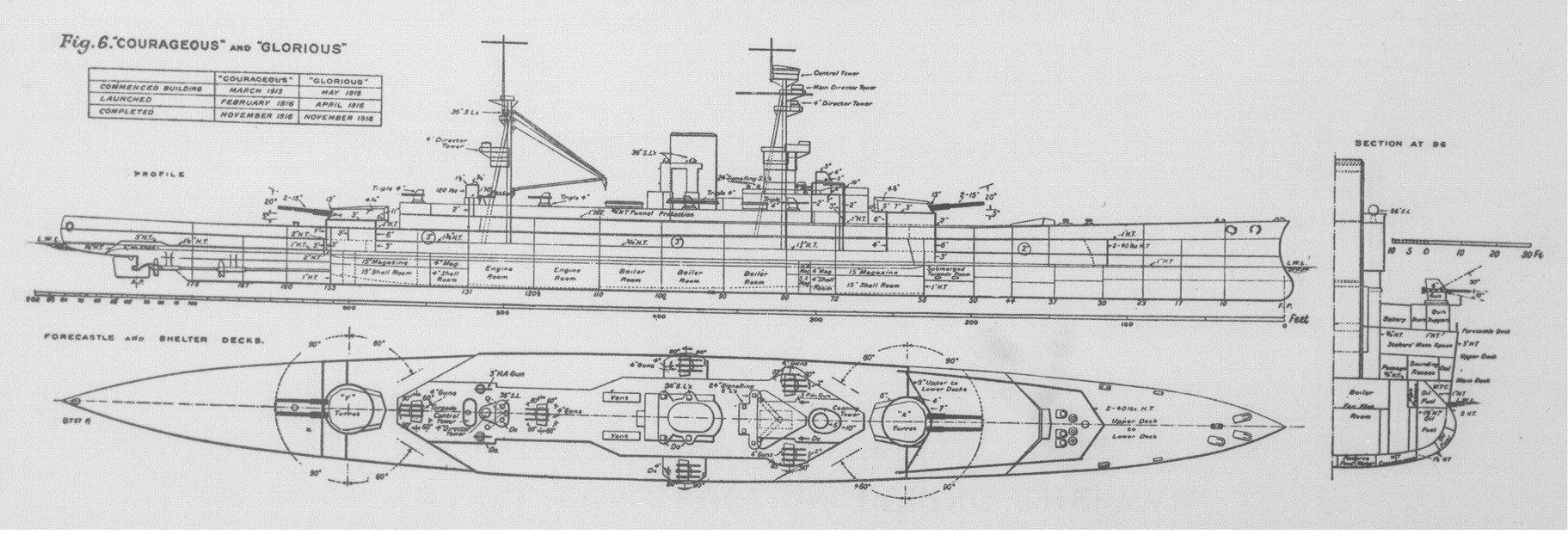
胡德号战列巡洋舰
胡德号,是英国海军第三种配备15英寸火炮的战列巡洋舰,该级的设计过程,是颇为曲折的。根据Norman Friedman(The British Battleship 1906-1946, P.182-186)和R. A. Burt(British Battleships 1919-1945, P.300-301)的说法:
With Fisher gone, the Admiralty returned to battleship design...In November 1915 the Treasury formally approved construction of a new capital ship. Initially Controller expected it to be a fast battleship...First Sea Lord (Admiral Jackson) was intent to pare the new design down to something affordable...In the end, the Board asked for a design with the same beam, draught, armour and with the armament and speed of a Queen Elizabeth, but to be shortened as much as possible.
费舍尔再度离任之后,海军部又开始准备战列舰设计了。1915年11月时,财政部批准可以建造新的主力舰了。起初,第三海务大臣打算建造的是快速战列舰。后来,第一海务大臣又提出要控制成本。最终,海军部委员会提出的要求是,设计一种三大性能与伊丽莎白女王级相当,宽度、吃水与其相同,但长度尽可能短的军舰。
Great attention was paid to a series of letters from the Commander-in-Chief, Admiral Jellicoe, who had the advantage of the latest war experience. His guidelines as set out in a letter dated 8 February 1916 reflected the following: We do not require to build battleships at the moment. Our superiority is very great and gives no cause for uneasiness in regard to this type of ship. Weakness in future will lie in the battlecruiser type. Any armoured vessel which we are building should be of the battlecruiser type and the need is great. Glorious is unable to compete with the German ships owing to inadequate protection and the same applies to the Repulse. In some battleship designs forwarded the speed varies from 25 to 27kts. This intermediate speed is to my mind of little use. Either they should be battlecruisers of 30kts or battleships of 22kts. I am attempting to use the Queen Elizabeth class as a fast wing but their excess in speed is of very little use and it is questionable whether they can get to head of the line of deployment without blanketing the battle line. Requirements are battlecruisers at 30kts. Not less than 8 guns.
大舰队总司令杰里科,基于他的战时经验,就这些军舰的设计问题写了不少信。他的声音,得到了海军部的重视。在1916年2月8日的一封信中,他阐述了自己的原则:首先,没必要再建造战列舰,因为英国在战列舰方面的优势已经非常巨大了,没必要再担心数量不足了。其次,英国海军在战列巡洋舰方面仍然有所不足,因此如果要建造主力舰的话,那么就应该建造战列巡洋舰。当时正在建造的声望级和勇敢级,防护水准太弱了,无法与德国军舰相抗衡。第三,海军部提交的部分战列舰设计方案,具备25-27节的航速,但杰里科认为,这种不上不下的航速,价值并不大。要么就建造22节航速的战列舰,要么就建造30节航速的战列巡洋舰。杰里科打算将伊丽莎白女王级战列舰,作为快速侧翼使用,但由于这些军舰的航速优势十分有限,因此在展开为战列线时,很难及时机动到头部位置。杰里科对新战列巡洋舰的要求是,至少8门大口径火炮、具备30节航速。
DNC ordered work begun on a new battlecruiser...Six alternative designs were developed. Except for Design 1, each had small-tube boilers. Each of Designs 1, 2 and 3 had eight 15in guns, Design 4 had four 15in B guns, Design 5 had six and Design 6 had eight 15in B guns. Each also had twelve 5.5in guns. All but Design 3 had narrow boiler rooms. That limited power output to 120,000 SHP and speed to about 30 knots. Design 3, with its wide boiler rooms, could produce 160,000 SHP and make 32 knots. As designed, the ship had an inward-sloping 8in waterline belt over the whole length of the magazines and machinery.
在此情况下,造舰局长开始准备战列巡洋舰的设计了,他们总共拿出了6个设计方案。在火力方面,这些方案的主炮配置有15英寸和18英寸两种,方案1、2、3都配备有8门15英寸火炮,方案4、5、6则分别配备有4、6、8门18英寸火炮;副炮配置则完全相同,都是12门5.5英寸火炮。在防护方面,采用的是倾斜布置的8英寸主装甲带,且完整覆盖了动力舱段和弹药库段。在动力方面,方案1采用的是大水管锅炉,其余则都是小水管锅炉。方案3的锅炉舱更大,能输出160,000轴马力,最大航速为32节;其余方案的锅炉舱较小,只能输出120,000轴马力,因此最大航速为30节。
Jellicoe’s requirement for eight heavy guns ruled out Designs 4 and 5, just as the extra weight of large-tube boilers ruled out Design 1. Controller proposed Design 3 as a basis for discussion. It received the Board Stamp on 3 March 1916. Although the preferred Design 3 was rated at 160,000 SHP, DNC pointed out that if revolutions could be kept reasonably low (‘perhaps … with gearing’) he could make do with 144,000 SHP, the figure ultimately adopted.
由于杰里科要求有8门大口径火炮,因此方案4和方案5被否决了。而方案1则因为大水管锅炉重量大而被否决了。第三海务大臣提议,将方案3作为进一步讨论的基础。1916年3月3日时,海军部委员会选定了方案3。尽管这个方案是按照160,000轴马力设计的,但造舰局长表示,如果能设法降低螺旋桨转速(比如采用带有减速齿轮的蒸汽轮机)的话,那么有144,000轴马力也就够了。这也是最终定下来的动力指标。
Construction of three ships (under the 1915-16 programme) was formally authorised in April 1916, the fourth being approved in July. HMS Hood was laid down on 31 May 1916, the day of Jutland. Of the others, Rodney and Howe were laid down in 1916 (9 and 16 October, respectively) and the fourth ship Anson was laid down on 9 November 1916. Only Hood was completed...Construction on Anson, Howe and Rodney was suspended in March 1917, the contracts being finally cancelled in October 1918.
1916年4月时,英国海军得到批准,可以建造3艘这种军舰;同年7月时,又获批了第4艘同型舰。在1916年5月31日,即日德兰海战爆发的那一天,胡德号开工了。另外三艘军舰,分别是10月9日开工的罗德尼号、10月16日开工的豪号、以及11月9日开工的安森号。不过,只有胡德号得以建成。另外三艘的建造工作,则是在1917年3月时就停止了,随后在1918年10月时被正式取消了。
As a result of experience at Jutland it was decided to modify the design to secure increased protection, it having been found possible substantially to improve this by accepting deeper draught and slightly reduced speed but without any radical alteration in the design as a whole. Improvements in gunnery and torpedo equipment, bridge and conning tower design, etc., were incorporated at the same time...The revised design, which represented a merging of battleship and battlecruiser characteristics, constituted what was then a unique combination of offensive power, protection and speed...The result would be a ship better protected above water than a Queen Elizabeth, with ‘infinitely improved protection against torpedo attack’, with the same armament and 6 knots faster.
在日德兰海战之后,基于相关的经验教训,英国海军的舰船设计师,又对胡德号的设计做出了调整。他们发现,可以在不对整体设计做出大幅度调整的前提下,以加深吃水和略微降低航速为代价,来大幅提高该舰的防护水准。除此之外,在火控和鱼雷设备、舰桥和司令塔设计等方面,也做出了调整。调整后的设计方案,融合了战列舰与战列巡洋舰的特征,火力、防护、机动性均十分优秀。与伊丽莎白女王级相比,胡德号的火力与其相当、装甲防护水准更好、水下防护水准有了大幅提升、且具备6节的航速优势。
胡德号的三视图
胡德号战列巡洋舰,配备有8门15英寸火炮、12门5.5英寸火炮、6具21英寸鱼雷发射管(2具水下+4具水上),主装甲带厚度12英寸,最大航速31节。
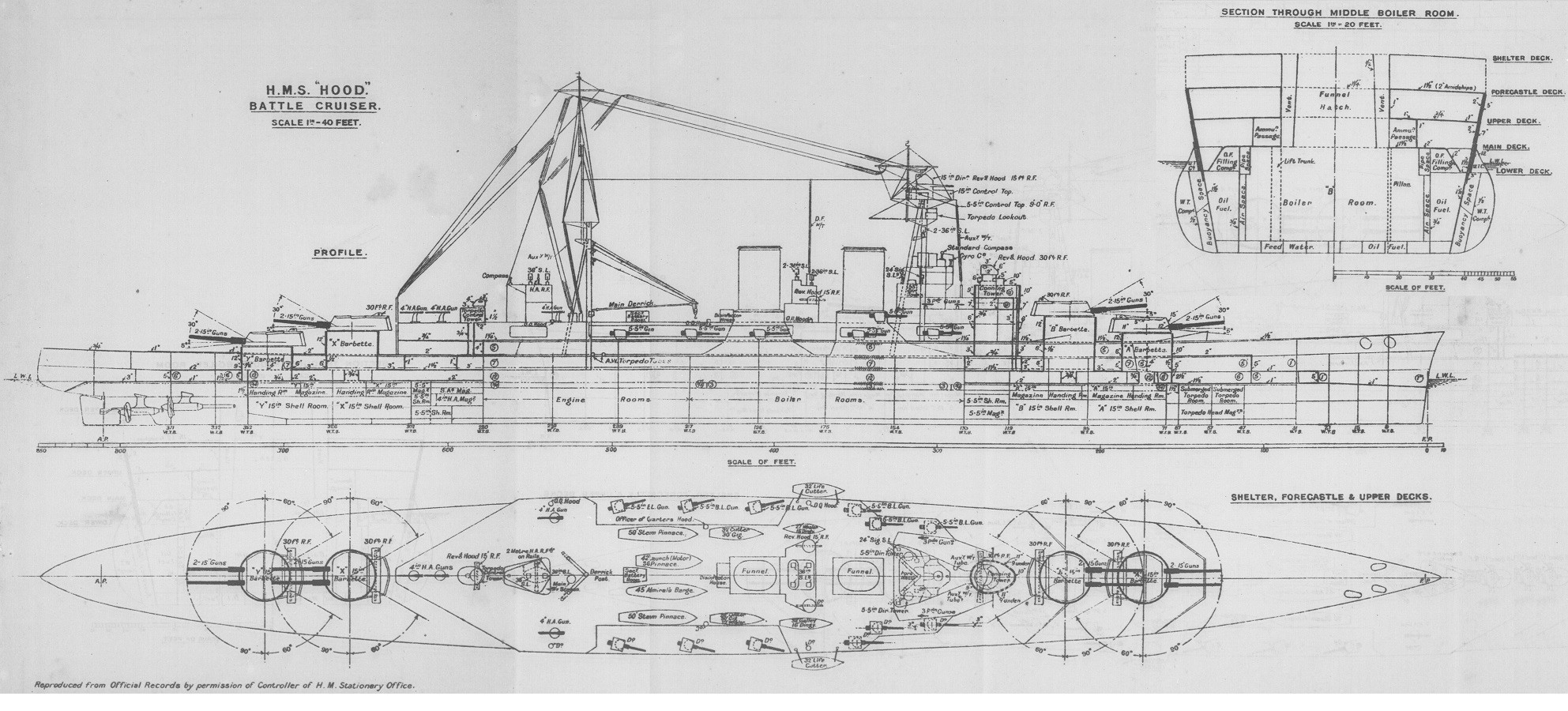
造价对比
在介绍完设计上的变迁之后,我们接下来将对那个时代的英国主力舰的造价进行详细对比,从而进一步探讨战列舰、战列巡洋舰、快速战列舰之间的关系。
1905-1920年间的英国主力舰的造价数据
下表中,列出了自无畏号至胡德号之间的所有英国主力舰(总共35艘战列舰、16艘战列巡洋舰)的造价、吨位、以及单位吨位造价。
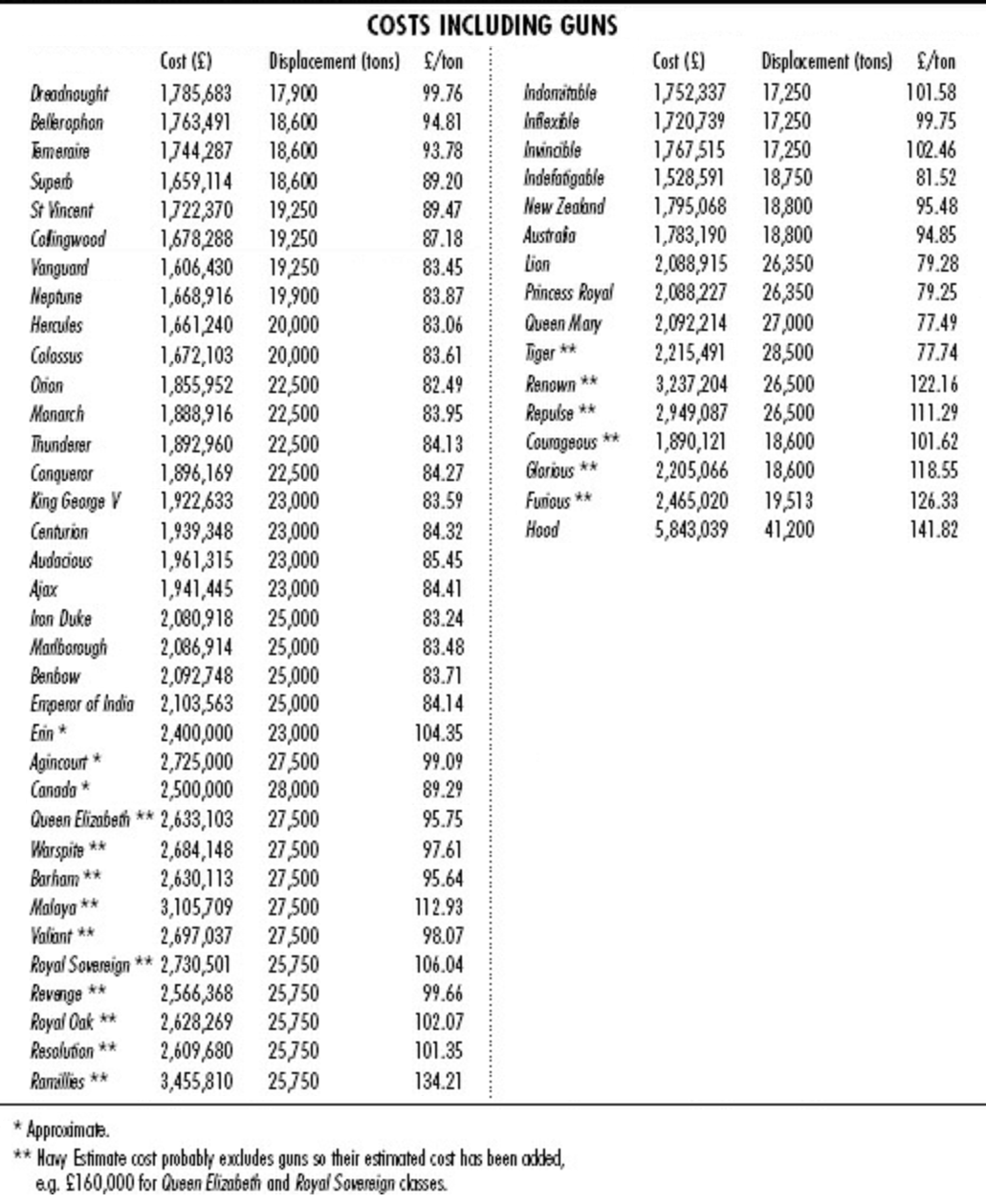
从上表中,我们可以发现以下三个现象:
首先,从12英寸到13.5英寸再到15英寸,每次火炮口径升级,军舰的造价也会有明显提升。其背后的原因,是火炮口径的提高(以及其他性能指标的提高)导致了吨位的提高,进而导致了造价的提高。
其次,在12英寸时代,战列舰的价格要比战列巡洋舰略高;而在13.5英寸时代,战列巡洋舰的价格则要高过战列舰。这个现象背后的直观原因,是吨位上的差异——在12英寸时代,战列舰的吨位普遍大于同期的战列巡洋舰;而在13.5英寸时代,战列舰的吨位普遍小于同期的战列巡洋舰。之所以会有这种吨位上的差异,其背后的根源因素则是设计指标上的差异——13.5英寸战列巡洋舰的火力、防护、机动性,均大幅高于12英寸战列巡洋舰;但13.5英寸战列舰和12英寸战列舰之间,则只是在火力方面存在明显差距,防护上的差距则没有那样明显,机动性方面更是几乎没有差异。换句话说,设计指标上的提高,导致了13.5英寸战列巡洋舰的造价超过了同时代的战列舰。
再者,战时建造的主力舰,造价和单位吨位造价,都显著高于战前建造的主力舰。这个现象背后的根源因素,是币值差异——在1914-1918年间,英镑的购买力下降了1倍——若不是因为货币贬值的原因,复仇级的造价显然应该比伊丽莎白女王级更低,声望级的造价想必也不会超过伊丽莎白女王级,而胡德号的造价则远不至于像历史上那么高(可能只需要300万英镑左右)。
结论:英国海军的战列舰和战列巡洋舰,尽管在性能需求上存在着明显的取舍差异,但在条件允许的情况下,他们也曾持续探索将这两种军舰进行融合的可行性。整体来说,在12英寸和13.5英寸火炮时代,英国海军建造的战列舰和战列巡洋舰,都遵循了设计委员会所设定的原则——战列舰强调火力和防护,战列巡洋舰则强调火力和航速。但在15英寸火炮时代,却出现了五种互相之间具有显著的差异的设计。之所以会出现这种情况,背后的核心原因有两个:一是性能要求,二是财政限制。其中,伊丽莎白女王级和胡德号是性能要求与先前的军舰不同,复仇级是财政限制下的产物,至于声望级和勇敢级,则都是在财政限制下,为了追求特定性能而牺牲了其他性能的设计。
从性能要求的角度说,在一战时期的技术环境下,像伊丽莎白女王级那样的,航速介于战列舰和战列巡洋舰之间的虚假的快速战列舰,是没有多大价值的。在对抗战列舰时,她们的航速优势意义不大;在对抗战列巡洋舰时,她们又不足以跟上对手。声望级那样的为了追求最大航速,而牺牲防护水准的设计,显然也是不合理的;勇敢级那样的极端设计,就更不可取了;毕竟,日德兰海战的战训,是难以撼动的。至于复仇级,则只能认为是无功无过的中庸设计。相比之下,胡德号那样的真正的快速战列舰,才是最佳选择。因为这类军舰,可以同时替代原先的低航速的战列舰和高航速的战列巡洋舰的组合。
从财政限制的角度说,性能要求的提高,必然意味着吨位和造价的提高。由于两强标准、对德六成优势这样的海军建设标准,都是以数量而非质量来衡量的,因此在有限的海军预算下,只有建造吨位和造价相对较低的军舰,才能达成既定的数量目标。换句话说,英国海军在12英寸和13.5英寸时代所选择的低航速的战列舰和高航速的战列巡洋舰的组合,似乎的确是财政限制下,最为合理的选择了。而三大性能均十分优秀的真正的快速战列舰,则由于造价过高的原因,往往很难得到海军部的批准。 |
